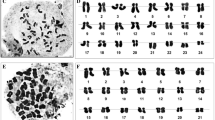Abstract
Comparative karyotype analysis of related species and populations has been used to describe patterns of chromosomal evolution within a group. In order to investigate cytogenetic variation in Achillea biebresteinii, root meristem zone of nine populations were removed and prepared using squash method. Image analysis system and Micro-measure software were implanted to karyotype providing cytogenetic parameter measurements. Although all the populations have the diploid chromosome number (2n = 18) and the haploid number (x = 9), but they could be differentiated by their karyotype formula and quantitative parameters of the karyotypes. Phenetic distance and principal component analysis showed that they could be classified in four clusters (groups). The mean chromosome length ranged from 3.82 (±0.48) to 7.77 (±0.12) µm. The chromosome types were detected as mostly metacentric (m) and submetacentric (sm), showing the karyotype formula of 18m (two populations), 16m + 2sm (five populations), 14m + 4sm (one population) and 2M + 14m + 2sm (one population). The karyotypes of the populations are almost similar. According to Stebbins’, the populations are classified to symmetric classes of 1A and 2A.



Similar content being viewed by others
References
Siljak-Yakovlev S, Peruzzi L (2012) Cytogenetic characterization of endemics: past and future. Plant Biosyst 146:694–702
Naruhashi N, Iwatsubo Y (1991) Cytotaxonomic study on two putative hybrids in the genus Duchesnea (Rosaceae). Bot Mag Tokyo 104:137–143
Coutinho LA (1952) Possibilitadades taxonomicas da citogenetica. Genetica Iber 4:21–42
Hanelt P, Mettin D (1989) Biosystematics of the genus Vicia L. (Leguminosae). Annu Rev Ecol Syst 20:199–223
Dewey DR (1984) The genomic system of classification as a guide to intergeneric hybridization with the perennial Triticeae. In: Gustafson JP (ed) Gene manipulation in plant improvement. Plenum Publish Corp, New York
Levitsky GA (1931) The karyotype in systematics. Bull Appl Bot Gene Plant Breed 27:220–240
Zheng-Yi W, Raven PH (1994) Flora of China, vol 17. Science Press, Missouri Botanical Garden
Goli SAH, Rahimmalek M, Sayed Tabatabaei BE (2008) Characteristics and fatty acid profile of yarrow (Achillea tenuifolia) seed oil. Int J Agric Biol 10:355–357
Danihelka J, Rotreklov O (2002) Achillea distans (Asteraceae) confirmed as native in the Bieszcady Mts (SE Poland). Fragmenta Floristica et Geobotanica 45:257–263
Ehrendorefer F, Guo YP (2006) Multidisciplinary studies on Achillea sensu lato (Compositae–Antemideae): new data on systematic and phylogeography. Willdenowia 36:69–87
Chehregani A, Heidarian M, Jalali F (2013) Cytological investigations on Achillea wilhelmsii C. Koch (Asteraceae) in the western part of Iran. Chromosome Bot 8:13–16
Mozaffarian V (2007) A dictionary of Iranian plant names. Farhang Moaser Publishers, Tehran
Karamenderes C, Apaydin S (2003) Antispasmodic effect of Achillea nobilis L. subsp. sipylea (O. Schwarz) Bässler on the rat isolated duodenum. J Ethenopharm 84:175–179
Benedek B, Kopp B (2007) Achillea millefolium L. s. l. revisited: recent findings confirm the traditional use. Wien Med Wochenschr 157:312–314
Zargari A (1996) Medicinal plants, 4th edn, vol 3. Tehran University Publication, Tehran
Sheidai M, Azanei N, Attar F (2009) New chromosome number and unreduced pollen formation in Achillea species (Asteraceae). Acta Biologica Szegediensis 53:39–43
Chehregani A, Javaheri F (2014) Variation of karyomorphological characters in Achillea aleppica DC. (Asteraceae) in the western part of Iran. Chromosome Bot 9:13–22
Ghahremaninezhad F, Nejad Falatoury A, Mahmoodi M, Hoseini E (2013) Plant chromosome book of Iran. Biology Home Press, Tehran
Morton JK (1981) Chromosome numbers in compositae from Canada and the U.S.A. Bot J Linn Soc 82:357–368
Efimov KF (1998) Chromosome numbers in some species of the families Asteraceae, Campanulaceae, Fabaceae from central Caucasus. Bot Žurn (Moscow & Leningrad) 83:131–132
Efimov KF (2005) Chromosome numbers of some species of the families Amaryllidaceae, Asteraceae, Fabaceae in North Osetia. Pages 33–35 in Karyology, Karyosystematics and Molecular Phylogeny. St. Petersburg, Russia
Chehregani A, Mohsenzaeh F, Moazen F (2012) Variation of chromosome numbers in Tanacetum parthenium Schultz Bip. (Asteraceae) in Iran. Chromosome Bot 7:97–100
Chehregani A, Mohsenzadeh F, Salehi H (2014) Investigations on chromosome variation in Achillea tenuifolia Lam and A. bieberestinii Afan (Asteraceae) from Hamedan and Kermanshah in the West of Iran. J Cell Mol Res 6:13–21
Stebbins GL (1971) Chromosomal evolution in higher plants. Addison-Wesley, London
Levan A, Fredga K, Sandberg AA (1964) Nomenclature for centromeric position on chromosomes. Hereditas 52:201–220
Ebrahimi F, Pakniyat H, Arzani A, Rahimmalek M (2012) Karyotype analysis and new chromosome number reports in Achillea species. Biologia 67:284–288
Verma BN (1980) Karyotype analysis is three species Rhizoclonim Kutze. Cytologia 45:433–440
Jafari A, Ejtehadi H, Taghizadeh N, Baradaran B (2008) Karyotype and seed protein analysis of Muscari neglectum (Liliaceae/Hyacinthaceae) populations in North-East of Iran. Asian J Plant Sci 7:730–735
Romero Zarco C (1986) A new method for estimating karyotype asymmetry. Taxon 35:526–530
Lavania UC, Srivastava S (1999) Quantitative delineation of karyotype variation in Papaver as a measure of phylogenetic differentiation and origin. Curr Sci 77:429–435
Chehregani A, Mehanfar A (2008) New chromosome counts in the Tribe Anthemideae (Asteraceae) from Iran. Cytologia 73:189–196
Sahin A, Kiran Y, Arabaci T, Turkoglu I (2006) Karyological notes on eight species of Achillea L. (Asteraceae, Santolinoideae) from Turkey. Bot J Linn Soc 151:573–580
Lavania UC, Srivastava S (1992) A simple parameter of dispersion index that serves as a adjunct to karyotype asymmetry. J Biosci 17:179–182
Paszko B (2006) A critical review and a new proposal of karyotype asymmetry indices. Plant Syst Evol 258:39–48
Mercado-Ruaro P, Delgado-Salinas A (1998) Karyotypic studies on species of Phaseolus (Fabaceae: Phaseolinae). Am J Bot 85:1–9
Ruas PM, Ruas CF, Maffei EMD, Marin-Morales MA (2000) Chromosome studies in the genus Mikania (Asteraceae). Genet Mol Biol 23:979–998
Costa JY, Forni-Martins ER (2003) Karyology of some Brazilian species of Alismataceae. Bot J Linn Soc 143:159–164
Acknowledgments
This research was done using a grant provided by research council of Bu-Ali Sina University.
Author information
Authors and Affiliations
Corresponding author
Rights and permissions
About this article
Cite this article
Chehregani Rad, A., Salehi, H. & Mohsenzadeh, F. Karyomorphological Analysis on Several Diploid Populations of Achillea biebersteinii Afan. (Asteraceae) from Iran. Proc. Natl. Acad. Sci., India, Sect. B Biol. Sci. 87, 173–180 (2017). https://doi.org/10.1007/s40011-015-0608-8
Received:
Revised:
Accepted:
Published:
Issue Date:
DOI: https://doi.org/10.1007/s40011-015-0608-8




